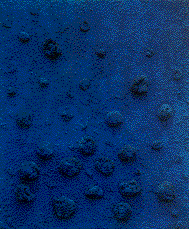

Monochrome Painting
Yves Klein, Requiem,1960.
Sponges, pebbles and dry pigment in
synthetic resin on board,
6 feet 6-/8 inches x 5 feet 4-1/8 inch
(1.99 x 1.65 x .15 m).
The Menil Collection, Houston.
The origins of monochrome painting lie early in the century, when Kazimir Malevich painted a white square on a white field in 1918. As an expression of a pure state of feeling, Malevich's painting offered a beacon of hope for abs tract painting s spiritual potential. Just three years later, Aleksandr Rodchenko exhibited a red, a yellow, and a blue painting, declaring that together they represented the final statement that could be made in the medium and thus signified the d eath of easel painting. These dual identities of monochrome painting as a vehicle for spiritual redemption and as the absolute end of painting have ebbed and flowed throughout the century. In France during the late 1950's and early 1960's, Yves Klein investigated monochrome as a painting of nothingness. His ultramarine canvases were the representation of the immaterial, the sovereign liberation of the spirit. Klein's investment of spiritual content in art stands in direct conflict with the more popular notion of painting as object, the object being an end in itself.One of the earliest manifestations of this sentiment in painting is the work of Frank Stella, whose frequently cited statement What you see is what you see encapsulates Minimalism's adoption of a pure abstraction devoid of any spiritual or metaphysical connotations. Minimalism emphasizes the materiality and shape of the object and denies any sense of personal touch in the work's execution. Such strategies are evident in Hard-edge paintings by Ellsworth Kelly and mon ochrome works by Robert Ryman. Kelly explores mass, color, and form through flatly painted shaped canvases of one color or multiple panels in different colors, which seem to dissolve into their surrounding space, denying the traditional edge of a painting s surface. The most complex investigation into monochrome has been undertaken by Ryman, who, since the mid-1960s', has diligently pursued various permutations of all-white painting, realizing an astonishing range of expression within a seemingly limited set of criteria.
The Museum of Non-Objective PaintingAbstraction in the Twentieth Century
Abstraction in:
Photography